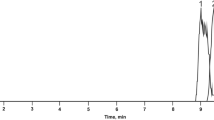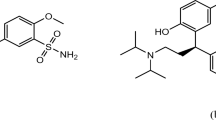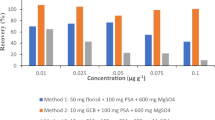Abstract
Urine samples were collected from 51 participants in a study investigating pesticide exposure among farm families in Iowa. Aliquots from the samples were sent to two different labs and analyzed for metabolites of atrazine (atrazine mercapturate), metolachlor (metolachlor mercapturate) and chlorpyrifos (TCP) by two different analytical methods: immunoassay and high performance liquid chromatography tandem mass spectrometry (HPLC-MS/MS). HPLC-MS/MS methods tend to be highly specific, but are costly and time consuming. Immunoassay methods are cheaper and faster, but can be less sensitive due to cross reactivity and matrix effects. Three statistical methods were employed to compare the two analytical methods. Each statistical method differed in how the samples that had results below the limit of detection (LOD) were treated. The first two methods involved an imputation procedure and the third method used maximum likelihood estimation (MLE). A fourth statistical method that modeled each lab separately using MLE was used for comparison. The immunoassay and HPLC-MS/MS methods were moderately correlated (correlation 0.40–0.49), but the immunoassay methods consistently had significantly higher geometric mean (GM) estimates for each pesticide metabolite. The GM estimates for atrazine mercapturate, metolachlor mercapturate, and TCP by immunoassay ranged from 0.16–0.98 μg l−1, 0.24–0.45 μg l−1 and 14–14 μg l−1, respectively and by HPLC-MS/MS ranged from 0.0015–0.0039 μg l−1, 0.12–0.16 μg l−1, and 2.9–3.0 μg l−1, respectively. Immunoassays tend to be cheaper and faster than HPLC-MS/MS, however, they may result in an upward bias of urinary pesticide metabolite levels.
This is a preview of subscription content, access via your institution
Access options
Subscribe to this journal
Receive 6 print issues and online access
$259.00 per year
only $43.17 per issue
Buy this article
- Purchase on SpringerLink
- Instant access to full article PDF
Prices may be subject to local taxes which are calculated during checkout



Similar content being viewed by others
References
Amistadi M.K., Hall J.K., Bogus E.R., and Mumma R.O. Comparison of gas chromatography and immunoassay methods for the detection of atrazine in water and soil. J Environ Sci Health B 1997: 32 (6): 845–860.
Arbuckle T.E., Cole D.C., Ritter L., and Ripley B.D. Biomonitoring of herbicides in Ontario farm applicators. Scand J Work Environ Health 2005: 31 (Suppl 1): 90–97.
Biagini R.E., Smith J.P., Sammons D.L., MacKenzie B.A., Striley C.A., Robertson S.K., and Snawder J.E. Development of a sensitivity enhanced multiplexed fluorescence covalent microbead immunosorbent assay (FCMIA) for the measurement of glyphosate, atrazine and metolachlor mercapturate in water and urine. Anal Bioanal Chem 2004: 379 (3): 368–374.
Biagini R.E., Tolos W., Sanderson W.T., Henningsen G.M., and MacKenzie B. Urinary biomonitoring for alachlor exposure in commercial pesticide applicators by immunoassay. Bull Environ Contam Toxicol 1995: 54 (2): 245–250.
Chuang J.C., Emon J.M.V., Durnford J., and Thomas K. Development and evaluation of an enzyme-linked immunosorbent assay (ELISA) method for the measurement of 2,4-dichlorophenoxyacetic acid in human urine. Nanoscience and Nanotechnology. Talanta 2005: 67 (3): 658–666.
Curwin B., Sanderson W., Reynolds S., Hein M., and Alavanja M. Pesticide use and practices in an Iowa farm family pesticide exposure study. J Agric Saf Health 2002: 8 (4): 423–433.
Curwin B.D., Hein M.J., Sanderson W.T., Barr D.B., Heederik D., Reynolds S.J., Ward E.M., and Alavanja M.C. Urinary and hand wipe pesticide levels among farmers and nonfarmers in Iowa. J Expo Anal Environ Epidemiol 2005: 15 (6): 500–508.
Curwin B.D., Hein M.J., Sanderson W.T., Striley C., Heederik D., Kromhout H., Reynolds S.J., and Alavanja M.C. Pesticide dose estimates for children of Iowa farmers and non-farmers. Environ Res 2007: 105 (3): 307–315.
EPA. Pesticide Sales and Usage: 2000 and 2001 Market Estimates, 2004 Biological and Economic Analysis Division, Office of Pesticide Programs, Office of Prevention, Pesticides, and Toxic substances, U.S. Environmental Protection Agency, Washington, DC http://www.epa.gov/oppbead1/pestsales/01pestsales/market_estimates2001.pdf.
Hammel J.P., Bhavnani S.M., Jones R.N., Forrest A., and Ambrose P.G. Comparison of censored regression and standard regression analyses for modeling relationships between antimicrobial susceptibility and patient- and institution-specific variables. Antimicrob Agents Chemother 2006: 50 (1): 62–67.
Hornung R.W., and Reed L.D. Estimation of average concentration in the presence of nondetectable values. App Occup and Environ Hyg 1990: 5 (1): 46–51.
Lubin J.H., Colt J.S., Camann D., Davis S., Cerhan J.R., Severson R.K., Bernstein L., and Hartge P. Epidemiologic evaluation of measurement data in the presence of detection limits. Environ Health Perspect 2004: 112 (17): 1691–1696.
MacKenzie B.A., Striley C.A., Biagini R.E., Stettler L.E., and Hines C.J. Improved rapid analytical method for the urinary determination of 3,5,6 trichloro-2-pyridinol, a metabolite of chlorpyrifos. Bull Environ Contam Toxicol 2000: 65 (1): 1–7.
Norrgran J., Bravo R., Bishop A.M., Restrepo P., Whitehead R.D., Needham L.L., and Barr D.B. Quantification of six herbicide metabolites in human urine. J Chromatography B 2006: 830 (2): 185–195.
Olsson A.O., Baker S.E., Nguyen J.V., Romanoff L.C., Udunka S.O., Walker R.D., Flemmen K.L., and Barr D.B. A liquid chromatography—tandem mass spectrometry multiresidue method for quantification of specific metabolites of organophosphorus pesticides, synthetic pyrethroids, selected herbicides, and deet in human urine. Anal Chem 2004: 76 (9): 2453–2461.
Perry M.J., Christiani D.C., Mathew J., Degenhardt D., Tortorelli J., Strauss J., and Sonzogni W.C. Urinalysis of atrazine exposure in farm pesticide applicators. Toxicol Ind Health 2000: 16 (7–8): 285–290.
Shimoi K., Kasai H., Yokota N., Toyokuni S., and Kinae N. Comparison between high-performance liquid chromatography and enzyme-linked immunosorbent assay for the determination of 8-hydroxy-2′-deoxyguanosine in human urine. Cancer Epidemiol Biomarkers Prev 2002: 11 (8): 767–770.
Thiébaut R., and Jacqmin-Gadda H. Mixed models for longitudinal left-censored repeated measures. Comput Methods Programs Biomed 2004: 74 (3): 255–260.
Author information
Authors and Affiliations
Corresponding author
Rights and permissions
About this article
Cite this article
Curwin, B., Hein, M., Barr, D. et al. Comparison of immunoassay and HPLC-MS/MS used to measure urinary metabolites of atrazine, metolachlor, and chlorpyrifos from farmers and non-farmers in Iowa. J Expo Sci Environ Epidemiol 20, 205–212 (2010). https://doi.org/10.1038/jes.2009.15
Received:
Accepted:
Published:
Issue date:
DOI: https://doi.org/10.1038/jes.2009.15
Keywords
This article is cited by
-
Quantifiable urine glyphosate levels detected in 99% of the French population, with higher values in men, in younger people, and in farmers
Environmental Science and Pollution Research (2022)
-
Longitudinal Assessment of Chlorpyrifos Exposure in Farmers and Residents of an Italian Alpine Region
Exposure and Health (2021)
-
Organophosphorus pesticide determination in biological specimens: bioanalytical and toxicological aspects
International Journal of Legal Medicine (2019)
-
Defined plant extracts can protect human cells against combined xenobiotic effects
Journal of Occupational Medicine and Toxicology (2011)



